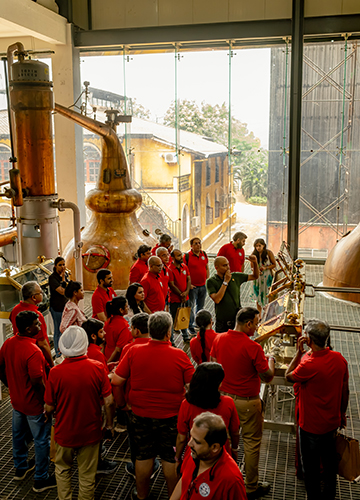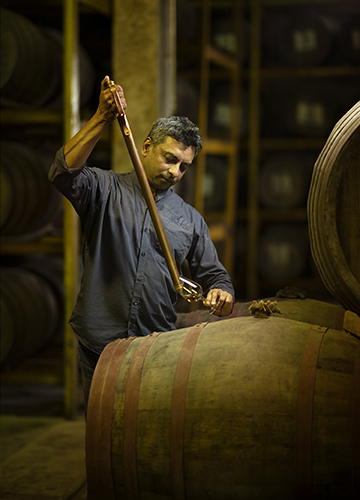Paul P. John’s first business venture crumbled, quite literally, like a cookie.
“There was a biscuit factory,” he recalls, “owned by a friend’s father that had shut down. I had just finished college, and was looking for something to do. I thought, ‘Why not biscuits? Everybody eats biscuits!’ So I took over and tried to run the factory, but it was a disaster. After two years, I had to close it down.”
That is how John, now a whisky pioneer known for his eponymous single-malt labels, entered the alcohol industry. In the 1990s, when he started out, alcohol was still taboo business. “In movies, especially Malayalam, [alcohol businessmen] were always portrayed as villains,” he laughs. “Back then, country liquor dominated the market―I would say most of the business was focused on that. The business model was… different.”
John’s father, T. John, a former Karnataka minister with roots in Kerala, had interests in plantations and liquor. With his family’s support, John converted the defunct biscuit factory into a distillery, launching the Original Choice whisky in 1996. It became a bestseller, with millions of cases sold, although its popularity was confined to India―long the largest whisky market by volume. Despite the commercial success, Original Choice did not win over the connoisseurs. A European Union trade official visiting India in 2003 said the blurry line separating Indian whisky from rum―both being distilled from molasses―could make for a “nice academic session”.
Even as Original Choice thrived in the late 2000s, John began exploring new horizons. He set up a base in Florida―a move reminiscent of Japanese whisky pioneer Masataka Taketsuru’s stint in Glasgow. Taketsuru was a businessman who, in 1918, had gone to Scotland to study organic chemistry. He apprenticed at several renowned distilleries, returned to Japan and joined a beverages company called Kotobukiya.
“In Florida,” says John, “I started tasting high-quality whiskies, including single malts. I thought, ‘This is something we don’t have back home.’ And that is how I decided to create single malts in India.”
Taketsuru had joined Kotobukiya in 1923 to craft Japan’s first authentic whisky. He went on to establish his first distillery in Yoichi, Hokkaido, a location chosen for its Glasgow-like climate.
In India, John selected Goa as the site for his distillery. “I decided to build the plant around 2005-06, and it took two to three years to complete,” says John. Michael D’Souza, his master distiller (the title often used for the expert who oversees whisky-making), faced unique challenges. “Whisky making is 50 per cent art and 50 per cent science,” says D’Souza. “Goa is hot and humid, so we had to adapt everything―from the pot stills to the process―to suit the conditions,” he says.
The first Paul John single malt was launched in the UK in 2012. “For the first four to five years, I focused on building the brand in Europe,” says John. “After winning several awards and gaining recognition there, I launched it in India.”
Kotobukiya is now the legendary brand Suntory, and Taketsuru is celebrated as the founding father of Japanese whisky. Could John, 57, be considered India’s own Taketsuru, given his reputation as a whisky visionary? He laughs off the comparison: “Taketsuru was truly a visionary.”
India may not have the whisky-making tradition of Scotland or Ireland, but it has entered an era of experimentation. “The Scots have 200 years of whisky-making knowledge. They know exactly what will happen after 25 years [of maturing],” says D’Souza. “We have not reached that level yet.”
Nevertheless, in 2014, Paul John whiskies outperformed renowned Scottish labels in blind tastings across eight UK cities, and they have since earned prestigious awards in London, Glasgow and San Francisco. Indian single malts in general have made their mark. Last year, a collector’s edition of Indri whisky from Piccadilly Distilleries in Haryana was named the world’s best whisky by Whiskies of the World, one of the largest whisky events in the US.
“The whisky market in India has evolved over the past 15 to 20 years,” says John. “Technology has improved the quality of distillation. We have moved from regular column distillation to vacuum distillation, which removes more impurities. Also, our entire plant was built by Indians, using Indian material.”
One challenge remains―sourcing peat, a key ingredient in whisky production. “We still haven’t found peat in India,” says John. “Most peat used worldwide comes from the UK, and we import ours from Scotland.”
Peat is a soil-like material that is formed when water accumulates in boggy areas over thousands of years, delaying the decomposition of grass, moss and tree roots. Its ready availability made it the primary domestic fuel in Scotland, and the peating of barley, which imbues it with the aromatic quality of phenols, gives whiskies its distinct smoky flavour. Peat is a hallmark of Scotch, though many respected whiskies are unpeated.
The global whisky landscape is changing. “Most awards at international whisky fairs are now won by non-Scottish brands,” says John. “Japan has some fantastic single malts, and India is high on that ladder as well.”
Looking ahead, John sees whisky culture spreading in India, with whisky appreciation clubs such as Bengaluru’s Single Malt Amateur Club and Goa’s Dram Club leading the way. Even smaller cities are catching on.
“Most of the action―tasting sessions and exclusive releases―is still in the metros,” says John. “But it’s just a matter of time before it spreads to every level of society.”




